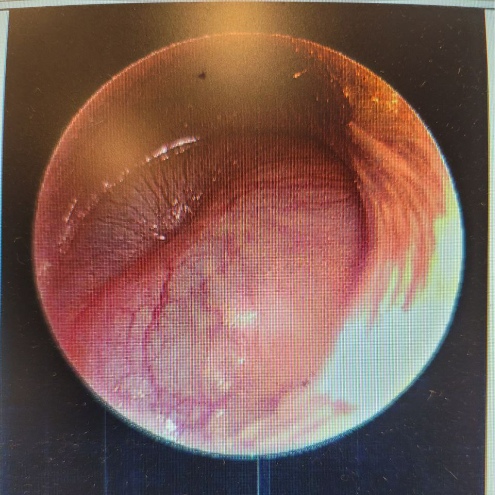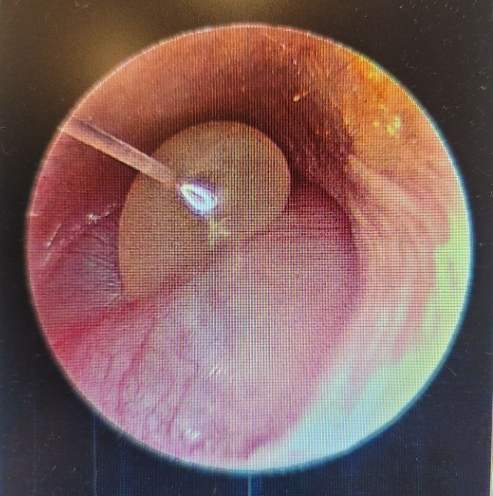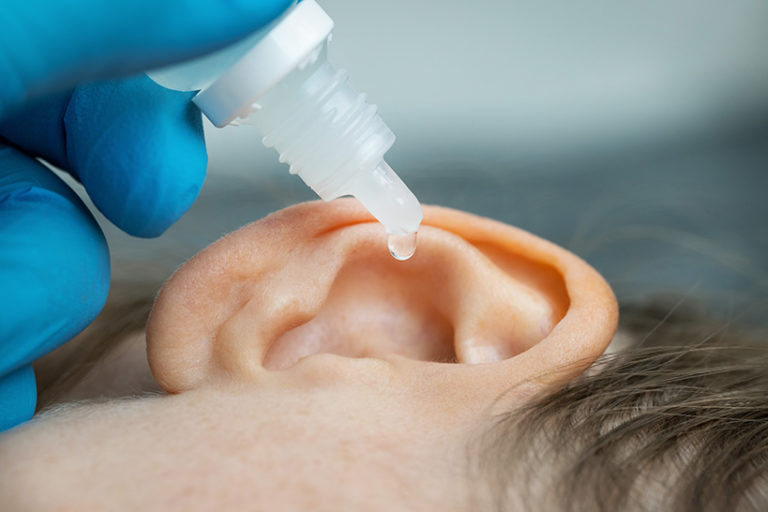Risks Of Not Treating Glue Ear With Grommets
You have been diagnosed with glue ear – it’s a condition where fluid gets stuck in the middle ear because of a malfunctioning Eustachian tube. It’s a common disease among children.
The doctor has suggested a grommet surgery – a grommet is a small tube that is placed into the eardrum to stabilize the pressure in the middle ear and drain the excess fluid. Grommets are recommended if someone suffers from 3 ear infections in 6 months.
It’s a pretty risk-free surgery with very few risks of accidents and complications happening. However, if you choose to avoid treatment and stick to plain antibiotics, what’ll happen?
Let’s find out.
Complications Of Glue Ear
Leaving glue ear (Otitis Media With Effusion) untreated might develop into more serious diseases. Due to persistent fluid in the middle car, the consequence could be-

Glue ear, after draining the ear drum

Glue ear, intact ear drum
Ongoing Conducive Hearing Loss
A conductive hearing loss happens when sounds cannot pass through the outer and middle ear. It’s hard to hear soft sounds. Louder sounds get muffled.
The present sticky fluid in the middle ear will continue causing this issue with hearing – which would’ve easily cured itself because the discharge would’ve drained out through the grommet.
Eardrum Rupture/Permanent Hearing Damage
Not continuing to treat the eardrums might cause the eardrums to rupture and cause permanent damage to your child’s hearing. This ruptured eardrum will allow more bacteria to enter the ear, causing more infections.
Tear In The Eardrum
The pressure from the long-lasting presence of fluid in the middle ear can develop a small tear in the eardrum. About 5% to 10% of children with an ear infection develop a tear like this. If the tear doesn’t heal on its own, surgeries are needed.
Delayed Speech And Language Development
Children need to hear to learn the language and develop speech properly. Muffled hearing or hearing loss for any length of time can significantly delay or hamper the development of these extremely important skills.
Decreased Quality Of Life
Having continuous earaches is extremely annoying, and it brings many problems. Ear pains cause your child to wake up in the middle of the night, easily annoyed mood, continuous crying – and overall deviation from normal life.
Spread Of The Infection
If an infection that doesn’t go away on its own, is left untreated or is not fully resolved with treatment – it may spread beyond the ear. It can damage the nearby mastoid bone (bone behind the ear). In some instances, the infection can spread to the membranes surrounding the brain and spinal cord – and cause meningitis.
Mastoiditis
This is a serious bacterial infection that affects the mastoid bone of the ear. It’s more common in children. Because so many vital structures pass through the mastoid, the infection can spread outside of the mastoid bone and cause serious health complications.
Most mastoiditis patients recover quickly and have no complications as long as the condition is diagnosed and treated quickly.
Cholesteatoma
A cholesteatoma is a collection of irregular skin cells deep inside your ear. This begins at the margin of the eardrum and invades the middle ear and mastoid. They’re rare, but if left untreated, these can damage the delicate bones inside your ear that are essential for hearing and balance.
Labyrinthitis
Labyrinthitis is an inner ear infection that affects and disrupts your sense of balance. It’s also called vestibular neuritis.
Petrositis
Petrositis refers to infection of the temporal bone, the bone in the skull that surrounds the ear. This infection happens deep in the inner ear. Unrecognized and under-treated petrositis can lead to clinically important complications – including meningitis, cranial nerve palsies, venous sinus thrombosis, subdural empyema, labyrinthitis, and death.
Facial Paralysis
Facial paralysis is the loss of facial movement because of nerve damage. Your facial muscles become weak and appear to droop. It might affect one or both sides of the face,
Meningitis
Meningitis is a swelling of the protective membranes covering the brain and spinal cord. A bacterial or viral infection of the fluid surrounding these usually causes swelling. However, certain drugs, injuries, cancer, and other types of infections can also cause meningitis.
One of the infections it can develop from is chronic otitis media. It causes this by direct extension through bone or the inner ear through a labyrinthine fistula caused by a cholesteatoma. In most chronic ear infections with cholesteatoma, multiple organisms, usually, gram-negative rods, are frequently identified in most chronic ear infections with cholesteatoma.
Subdural Empyema
Subdural empyema (abscess) is an intracranial focal collection of purulent material located between the dura mater and the arachnoid mater. Subdural empyema can progress to meningitis, cortical venous thrombosis, or brain abscess. Subdural empyema can also rapidly spread to involve an entire cerebral hemisphere.
Brain Abscess
A brain abscess is a pus-filled pocket of infected material in your brain. It’s sometimes called a cerebral abscess. An abscess can cause swelling in the brain and put dangerous pressure on the brain tissues. This can also cause blood blockage in certain places of your brain. This is extremely life-threatening.
Closing Thought
If you aren’t unlucky most of these spreads and complications won’t happen to you or your child. But why take the risk? All this can be avoided with a simple grommet surgery which brings very few risks. So, you are recommended to treat your glue ear with grommets.
- About the Author
- Latest Posts
Dr Ronald Chin is an Australian trained Otolaryngologist Head and Neck Surgeon.
After graduating as a Fellow of the Royal Australasian College of Surgeons, Dr Chin undertook further specialised training in Head and Neck Cancer at the Royal College of Surgeons in Ireland.
He has published many research papers and is an active teacher and scholar.
As part of his subspecialty training, Dr Chin has training in Laser, Da Vinci Robotic, Flex Robotic and complex surgical techniques.
In addition to specialised Head and Neck Cancer, Dr Chin also enjoys general adult and paediatric ENT Surgery and practices sinus, snoring/sleep and general paediatric ENT Surgical procedures.
Dr Ronald Chin works as a general Otolaryngologist, offering a wide range of surgical and non-surgical treatments including ear surgery, nose surgery and throat surgery. He provides treatment for chronic conditions such as tonsillitis, sinus problems and problems with hearing.
He is also involved in the diagnosis and treatment of many conditions such as facial paralysis, head and neck cancer and sleep apnea. As well as performing surgery on children, he also provides specialist care for adults, including the treatment of throat disorders, voice loss and ear problems.
Dr Chin has also served as a Conjoint Associate Professor at the University of Sydney, a Conjoint Associate Professor at Western Sydney University and an Adjunct Associate Professor at the University of Technology Sydney.








